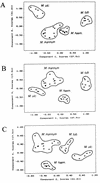Differentiation of Mycobacterium ulcerans, M. marinum, and M. haemophilum: mapping of their relationships to M. tuberculosis by fatty acid profile analysis, DNA-DNA hybridization, and 16S rRNA gene sequence analysis
- PMID: 9542909
- PMCID: PMC104661
- DOI: 10.1128/JCM.36.4.918-925.1998
Differentiation of Mycobacterium ulcerans, M. marinum, and M. haemophilum: mapping of their relationships to M. tuberculosis by fatty acid profile analysis, DNA-DNA hybridization, and 16S rRNA gene sequence analysis
Abstract
Although Mycobacterium ulcerans, M. marinum, and M. haemophilum are closely related, their exact taxonomic placements have not been determined. We performed gas chromatography of fatty acids and alcohols, as well as DNA-DNA hybridization and 16S rRNA gene sequence analysis, to clarify their relationships to each other and to M. tuberculosis. M. ulcerans and M. marinum were most closely related to one another, and each displayed very strong genetic affinities to M. tuberculosis; they are actually the two mycobacterial species outside the M. tuberculosis complex most closely related to M. tuberculosis. M. haemophilum was more distinct from M. ulcerans and M. marinum, and it appeared to be as related to these two species as to M. tuberculosis. These results are important with regard to the development of diagnostic and epidemiological tools such as species-specific DNA probes and PCR assays for M. ulcerans, M. marinum, and M. haemophilum. In addition, the finding that M. ulcerans and M. marinum are more closely related to M. tuberculosis than are other pathogenic mycobacterial species suggests that they may be evaluated as useful models for studying the pathogenesis of M. tuberculosis. M. marinum may be particularly useful in this regard since strains of this species grow much more rapidly than M. tuberculosis and yet can cause systemic disease in immunocompromised hosts.
Figures



Similar articles
-
Comparative genetic analysis of Mycobacterium ulcerans and Mycobacterium marinum reveals evidence of recent divergence.J Bacteriol. 2000 Nov;182(22):6322-30. doi: 10.1128/JB.182.22.6322-6330.2000. J Bacteriol. 2000. PMID: 11053375 Free PMC article.
-
Evaluation of PCR-restriction profile analysis and IS2404 restriction fragment length polymorphism and amplified fragment length polymorphism fingerprinting for identification and typing of Mycobacterium ulcerans and M. marinum.J Clin Microbiol. 2001 Sep;39(9):3272-8. doi: 10.1128/JCM.39.9.3272-3278.2001. J Clin Microbiol. 2001. PMID: 11526162 Free PMC article.
-
Characterization of an unusual Mycobacterium: a possible missing link between Mycobacterium marinum and Mycobacterium ulcerans.J Clin Microbiol. 2002 Jul;40(7):2370-80. doi: 10.1128/JCM.40.7.2370-2380.2002. J Clin Microbiol. 2002. PMID: 12089250 Free PMC article.
-
The genome, evolution and diversity of Mycobacterium ulcerans.Infect Genet Evol. 2012 Apr;12(3):522-9. doi: 10.1016/j.meegid.2012.01.018. Epub 2012 Jan 28. Infect Genet Evol. 2012. PMID: 22306192 Review.
-
[Mycobacterium shinshuense and Mycobacterium leprae infections: usefulness of genetical examinations].Nihon Hansenbyo Gakkai Zasshi. 2007 Sep;76(3):245-50. doi: 10.5025/hansen.76.245. Nihon Hansenbyo Gakkai Zasshi. 2007. PMID: 17877036 Review. Japanese.
Cited by
-
A simple PCR method for rapid genotype analysis of Mycobacterium ulcerans.J Clin Microbiol. 2000 Apr;38(4):1482-7. doi: 10.1128/JCM.38.4.1482-1487.2000. J Clin Microbiol. 2000. PMID: 10747130 Free PMC article.
-
Transposon mutagenesis of Mycobacterium marinum identifies a locus linking pigmentation and intracellular survival.Infect Immun. 2003 Feb;71(2):922-9. doi: 10.1128/IAI.71.2.922-929.2003. Infect Immun. 2003. PMID: 12540574 Free PMC article.
-
Genotyping Mycobacterium ulcerans and Mycobacterium marinum by using mycobacterial interspersed repetitive units.J Bacteriol. 2005 Mar;187(5):1639-47. doi: 10.1128/JB.187.5.1639-1647.2005. J Bacteriol. 2005. PMID: 15716434 Free PMC article.
-
Partial purification and characterization of biological effects of a lipid toxin produced by Mycobacterium ulcerans.Infect Immun. 1998 Feb;66(2):587-93. doi: 10.1128/IAI.66.2.587-593.1998. Infect Immun. 1998. PMID: 9453613 Free PMC article.
-
Molecular diagnostics in tuberculosis: basis and implications for therapy.Mol Diagn Ther. 2009;13(3):137-51. doi: 10.1007/BF03256322. Mol Diagn Ther. 2009. PMID: 19650669 Review.
References
-
- Allen S. Buruli ulcer and HIV infection. Int J Dermatol. 1992;31:744. - PubMed
-
- Athwal R S, Deo S S, Imaeda T. Deoxyribonucleic acid relatedness among Mycobacterium leprae, Mycobacterium lepramurium, and selected bacteria by dot blot and spectrophotometric deoxyribonucleic acid hybridization assays. Int J Syst Bacteriol. 1984;34:371–375.
-
- Burchard G D, Bierther M. Buruli ulcer: clinical pathological study of 23 patients in Lambarene, Gabon. Trop Med Parasitol. 1986;37:1–8. - PubMed
Publication types
MeSH terms
Substances
LinkOut - more resources
Full Text Sources
Other Literature Sources
Molecular Biology Databases

